|
|||
Update of the US Dollar IndexDavid Petch I thought it would be good to post the USD action of late and why it is affecting other markets. I will not be posting any other technical analysis reports for sometime. Instead they will be research-related topics over the course of the next 4-6 months. The lower 55 MA Bollinger band is still drifting well below the current index value, suggestive a base has not yet been established. The upper Bollinger bands are still declining, suggestive the USD has another 4-6 weeks of grinding higher before a top is put in place. Fibonacci time extensions of various waves are shown near the lower portion of the chart, with various Fib dates in late to early July. Short-term stochastics have the %K beneath the %D, with another 1-2 weeks of upside at a minimum before a brief downside move occurs (only to resume a grinding upward trend to 83-83.5). 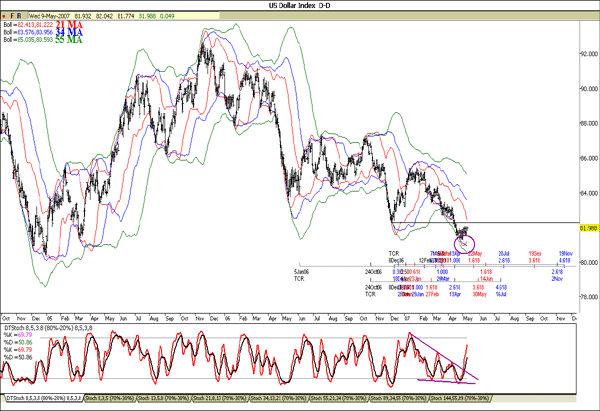 Blue lines on the right hand side represent Fibonacci price projections of downward trending wave price action projected off the subsequent retracement. Red lines represent Fibonacci price retracements of the move from early January 2005 until the late April 2006 top. Areas of line overlap form Fib clusters, which indicate important Fib support/resistance levels. There is strong resistance around 82.2-82.4, so expect the sideways action to continue until this level is taken out. One Babson channel contains the footprint of the USD from November 2005 till present, while another contains June 2006 till present. Notice how both channels form a wedge that terminates anywhere from October 2007 until January 2008, depending upon how the channels are drawn. Based upon this observation, the decline in the USD for this leg down could continue for some time. Moving averages are in bearish alignment (200 day MA above the 155 day MA above the 50 day MA), with the 50 day MA acting as support at 82.706. Full stochastics have the %K above the %D, with at least 4-6 weeks of upside if the %K reaches the upper horizontal channel line. This suggests "do not go short on the US dollar". The USD could continue to drop, but based upon the technical's, there is a possibility for the upward grinding action to continue. 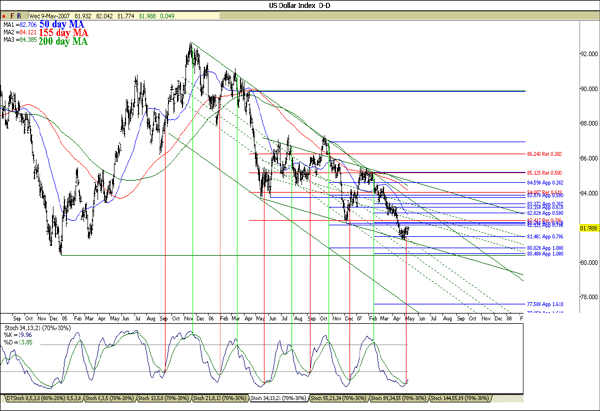 The weekly USD index is shown below, with Fibonacci time extensions of the decline shown at the top of the chart and Fib price projections of the decline projected off the April 2006 partial retracement on the right hand side of the chart (denote din blue). The lower Bollinger bands are in close proximity, suggestive the USD decline is set to continue after the current retracement move is done. The upper trend line of the Babson channel has proven to be strong resistance, with resistance around 83-83.5. A decline in the dollar below the 80 cent level would cause severe economic losses for many global pension funds, governments and investors, so it is highly unlikely that the dollar will NOT continue to receive support from foreign countries. As such, expect the USD to remain above 80 until late 2009/early 2010. Full stochastics have the %K beneath the %D, indicating the downward trend in place since April 2006 is not yet over. A bottom is likely due between October 2007 and January 2008. 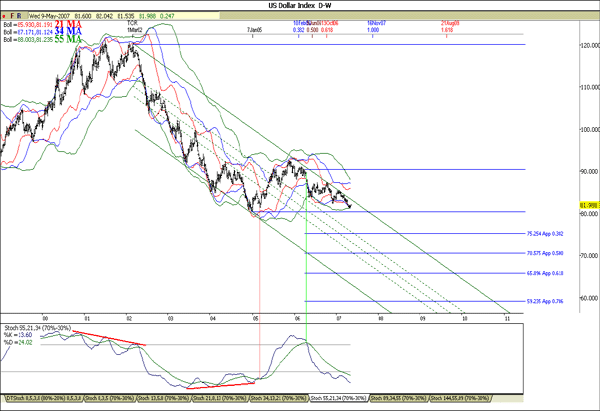 The mid-term Elliott Wave chart of the USD index is shown below, with the thought path denoted in green. The USD should retrace the decline to somewhere between 83-83.5 before continuing the descent to the 80.3 level later this year. Wave [B] is taking the form of a flat, with wave C forming a terminal impulse (3-3-3-3-3). There are numerous ways to count waves 1,2 and 3 but for simplicity, I have kept the count only labeled to the Minor Degree (pink). The upward move should continue until mid to late June before declining slowly into October 2007 or later. 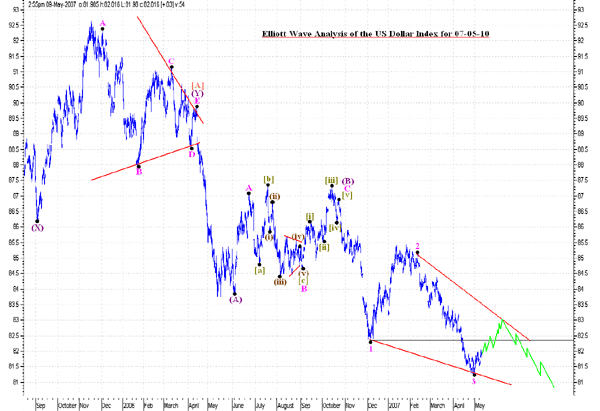 The long-term Elliott Wave chart of the USD index is shown below with the thought path denoted in green. Wave C.(W).[A] and [c].W.(X).[A] were elongated flats; elongated flats usually occur in triangles, which lead to the hypothesis that a non-limiting triangle is currently developing. After wave [B] completes, wave [C] should head back up higher to 83-84 over the course of mid to late 2008. 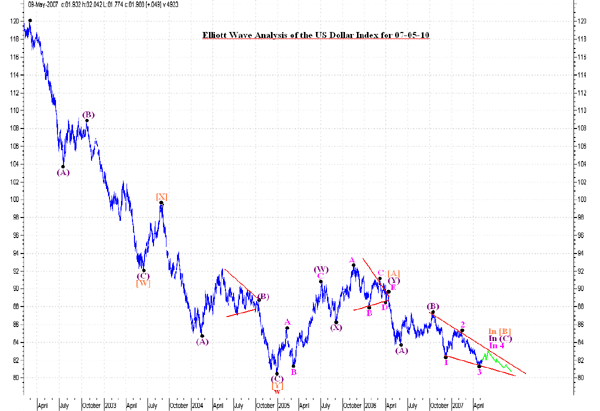 May 10, 2007 |
